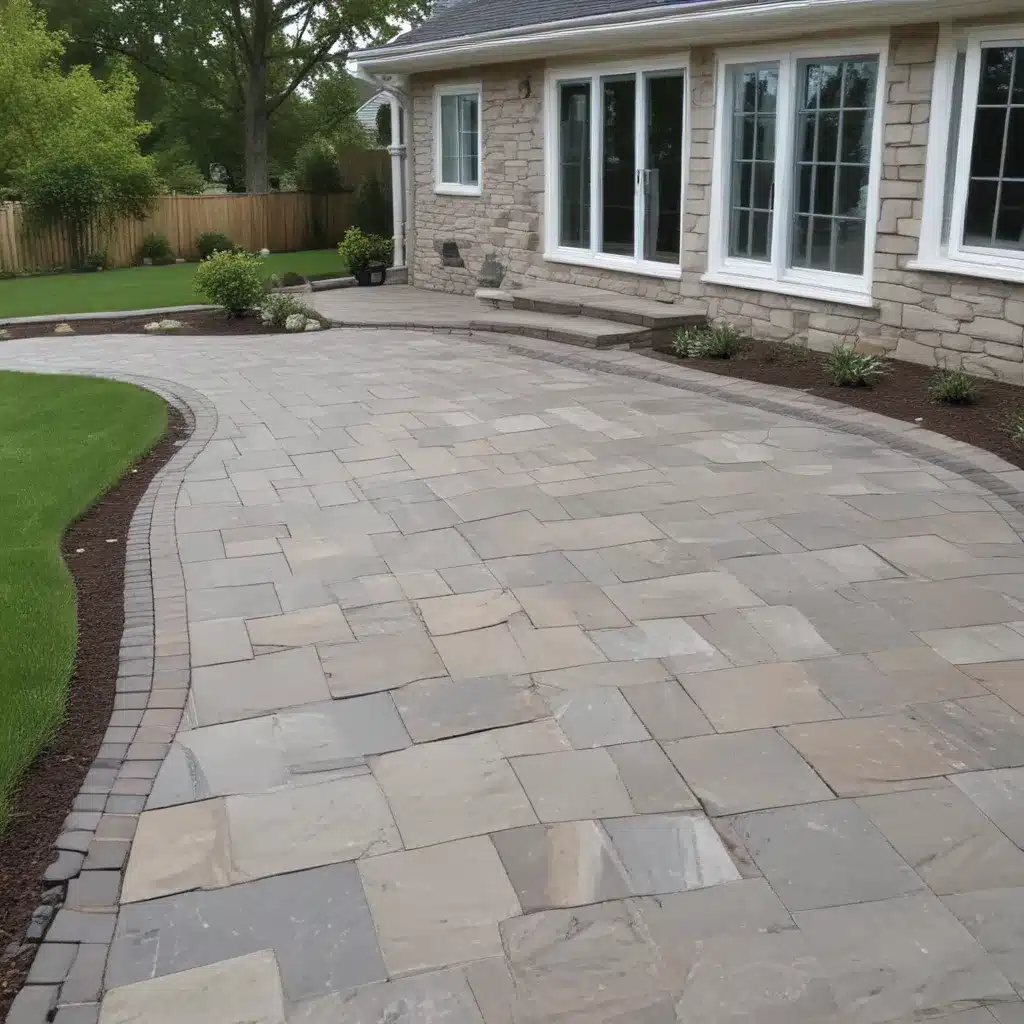
Patio Paving Trends
Timeless Classics: Certain patio paving materials and patterns have stood the test of time, offering a timeless and elegant aesthetic. Natural stone pavers, such as flagstone, travertine, or bluestone, exude a sense of permanence and Old-World charm. Classic running bond or herringbone patterns in brick or concrete pavers also imbue a traditional look that complements a variety of architectural styles.
Modern Minimalism: In contrast, contemporary patio designs often favor a sleek, minimalist approach. Large-format concrete or porcelain tile pavers in muted, monochromatic color palettes create a clean, streamlined appearance. Geometric patterns, such as staggered rectangular layouts or sharp-angled designs, lend an air of modern sophistication to outdoor living spaces.
Rustic Charm: For a more casual, nature-inspired vibe, reclaimed or tumbled paving materials like weathered brick, cobblestone, or textured natural stone can inject a sense of rustic charm. Irregular, organic patterns mimic the irregular contours of natural landscapes, while earthy hues and distressed finishes evoke a time-worn, lived-in ambiance.
Outdoor Design Ideas
Cohesive Color Schemes: When planning your patio design, consider establishing a cohesive color scheme that ties the various hardscape and landscape elements together. Selecting pavers in complementary shades, such as warm earth tones or cool gray hues, can create a visually harmonious and polished look. You can then accentuate the color scheme with coordinating outdoor furniture, planters, and accessories.
Textural Contrast: Layering different paving textures and materials can add visual interest and depth to your outdoor living space. For example, combining smooth, polished concrete pavers with rougher, tumbled natural stone can create a captivating juxtaposition. Textural contrast can also be achieved by incorporating features like water elements, decorative rock gardens, or lush plantings to break up the hardscape.
Seamless Integration: Blending your patio with the surrounding landscape is key to achieving a cohesive, visually appealing outdoor oasis. Opt for paving materials that complement the existing architecture and landscaping, such as selecting pavers that echo the color and style of your home’s exterior. Thoughtful integration of the patio with pathways, garden beds, and other outdoor amenities can create a harmonious, immersive experience.
Installation Techniques
Proper Surface Preparation: The foundation of a durable and long-lasting patio is proper surface preparation. This involves ensuring the subbase is compacted, level, and free of any debris or organic matter. Depending on the specific paving material, you may need to install a geotextile fabric or a granular base to promote drainage and prevent settling.
Laying Patterns and Bonding: The installation pattern you choose can significantly impact the visual appeal and structural integrity of your patio. Classic patterns like running bond, herringbone, or basket-weave not only create visually interesting designs but also interlock the pavers for enhanced stability. Proper bonding techniques, such as using a polymeric sand or mortar between the joints, are crucial for maintaining a unified, long-lasting surface.
Finishing Touches: The final steps in patio installation often involve adding edging, such as concrete or metal restraints, to contain the pavers and prevent them from shifting. Incorporating features like outdoor lighting, seating walls, or built-in planters can also elevate the overall aesthetic and functionality of your outdoor living space.
Maintenance Guidelines
Cleaning and Sealing: Regular cleaning and sealing of your patio pavers are essential for preserving their appearance and protecting the surface from the elements. Refer to the cleaning techniques outlined in the OxiClean source to effectively remove dirt, stains, and grime. Applying a high-quality sealer can also help prevent water damage, fading, and the growth of weeds or moss.
Repair and Replacement: Despite your best efforts, individual pavers may become chipped, cracked, or displaced over time. Addressing these issues promptly by replacing or resetting affected pavers can help maintain the overall integrity and appearance of your patio. Consulting a professional Cincinnati Patiopaving can ensure proper repair techniques are used to seamlessly integrate new pavers into the existing surface.
Seasonal Upkeep: Depending on your climate, seasonal maintenance tasks may be required to keep your patio in top condition. In colder regions, you may need to apply a de-icer or sand to prevent slipping during the winter months. In warmer climates, regularly removing leaves, debris, and weeds can help preserve the patio’s clean, well-maintained look.
Cost Comparisons
Material Pricing: The cost of patio paving materials can vary widely, depending on the type, quality, and source. Generally, natural stone pavers tend to be the most expensive, with prices ranging from $10 to $30 per square foot or more. Concrete and brick pavers are typically more affordable, typically costing between $5 and $15 per square foot. Porcelain and other manufactured pavers can fall within this range as well, with the potential for lower prices when purchased in bulk.
Labor Expenses: The labor costs associated with patio installation can also have a significant impact on the overall project budget. Factors such as the complexity of the design, the size of the patio, and the experience level of the installers can all influence the hourly or per-square-foot labor rates. On average, homeowners can expect to pay between $5 and $15 per square foot for professional patio installation, with higher-end projects potentially exceeding $20 per square foot.
Long-Term Considerations: When evaluating the cost of your patio project, it’s essential to consider the long-term maintenance and durability of the materials. While more expensive paving options may have a higher upfront cost, they may offer greater longevity, easier maintenance, and a higher return on investment when it comes time to sell your home. Conversely, less expensive materials may require more frequent repairs or replacement, ultimately costing more over the life of the patio.
Transforming your outdoor living space from drab to fab can be a rewarding and impactful investment. By understanding the latest patio paving trends, incorporating thoughtful design elements, and implementing proper installation and maintenance techniques, you can create a beautiful and functional outdoor oasis that enhances your home’s value and your family’s enjoyment. Consult with experienced professionals at Cincinnati Patiopaving to ensure your patio project exceeds your expectations and stands the test of time.

